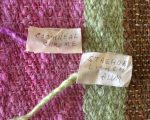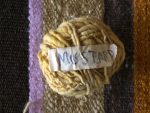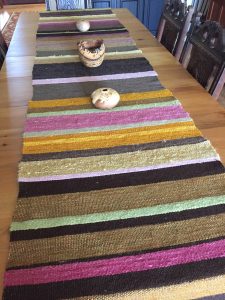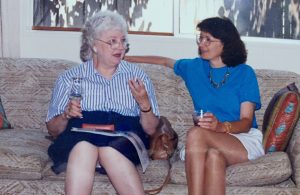There was a very familiar voice from the past on my answering machine a while back. . . “Vilija, This is Wilma. We were in the weaving guilds together at one time. I’m not weaving any more and I need to know what to do with all my yarns. Give me a call if you can, at . . . “
Now a very sharp 85 years old, but with “bum” knees, Wilma had decided that some of her previous life needed to be sorted out and given to new homes. I know that when staring at my burgeoning “studio” a few years ago, the thought of what to do with all my stash [palette] of weaving yarns, spinning fibers, beads, and, most of all, my collection of equipment, hit me hard. I slowly began culling. But then there’s “Stitches”, conference vendors, workshops with lots of stuff I can’t live without, and other weavers’ collections that make their way to my shelves. I’ve lately decided that, if I’m lucky, I’ll do as Wilma did. Call a younger weaver and give her or him the OFFER.
Wilma and I met through Creative Handweavers, which is no longer around, but in the 1980’s and 90’s it was a very active, truly creative group of women. You certainly didn’t need a traditional loom to be in this group. A product of their times, anything could be woven with, and anything could be woven on. Yes, there were those of us who stuck with the floor looms, but many were so much more adventurous.
An accomplished water colorist, Wilma really loved to spin “textured” wool yarn then search the countryside for dye plants to give her yarns the colors she loved in painting. When my family first moved back to California, there was a lovely, several acre tract in Walnut Creek with many years old oaks and a few old walnut trees. In the spring the entire floor under the trees blossomed with a dazzling carpet of bright yellow mustard. It was a delight to see every spring. Just blocks from her house, Wilma went many times to pick the blossoms for dye. One office worker or another in the building next door would always come down to ask what the heck was she doing. The field is now a shopping center, though with a few saved trees, but no mustard.

eucalyptus

lichen

all yarn
Among the many boxes of yarns in Wilma’s palette, were balls here and there of her long ago spun yarn dyed with natural dyes. Some of the balls had “mustard” labels on them and we remembered where those blossoms had come from. We put all those balls of wool aside. Some of her yarns went to members of Diablo Weavers,

mustard
the guild Wilma belonged to last, and some of it went to the East Bay Depot for Creative Reuse. A fair amount of the woolen yarns were taken by one member of Diablo for her knitting group which ended up making dozens of winter hats for the homeless in the greater Bay Area.

runner
My loom is not heavy enough to weave a rug, which is what the naturally dyed balls of wool would have been perfect for. But they spoke to me and I had to weave something. Something I would use and enjoy. A simple, rustic, tabby weave runner came to mind for my dining room table. It is a long, pine, hand-made table from one of the Mennonite communities of Indiana. That would be good.
There are various golds and yellows from onion skins, marigolds, eucalyptus leaves and mustard blossoms. A deep, rich coffee bean brown from walnut hulls. Soft greens from lichen and staghorn lichen. Soft pinks and rich pinks from cochineal and madder root [easy to grow your own]. A mahogany pink from cochineal and iron. Every thing that reminds me of my own early weaving and dyeing experiments. You had to love gold in those days!
So my runner from Wilma’s yarns is plain, in that it’s a simple tabby weave. But to me, it is far from ordinary because it brings back so many happy time memories. Thanks Wilma.

Wilma & Vilija circa 1991 at the annual Diablo picnic
Vilija states: I don’t weave as much as I’d like. While weaving is definitely my favorite textile process, spinning, knitting, and striving to make crochet “not your Grandma’s crochet”, take too much time away from my loom. But even then, my mind keeps creating new weaving projects, which I eventually pick and choose to actually make. That’s my excuse anyway, and I’m sticking to it.